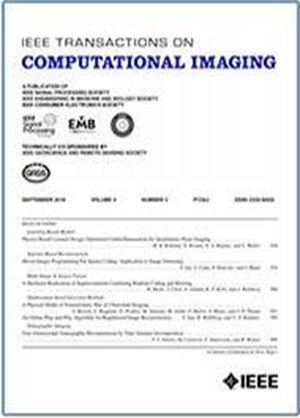Learned Discrepancy Reconstruction and Benchmark Dataset for Magnetic Particle Imaging
IF 4.8
2区 计算机科学
Q2 ENGINEERING, ELECTRICAL & ELECTRONIC
引用次数: 0
Abstract
Magnetic Particle Imaging (MPI) is an emerging imaging modality based on the magnetic response of superparamagnetic iron oxide nanoparticles to achieve high-resolution and real-time imaging without harmful radiation. One key challenge in the MPI image reconstruction task arises from its underlying noise model, which does not fulfill the implicit Gaussian assumptions that are made when applying traditional reconstruction approaches. To address this challenge, we introduce the Learned Discrepancy Approach, a novel learning-based reconstruction method for inverse problems that includes a learned discrepancy function. It enhances traditional techniques by incorporating an invertible neural network to explicitly model problem-specific noise distributions. This approach does not rely on implicit Gaussian noise assumptions, making it especially suited to handle the sophisticated noise model in MPI and also applicable to other inverse problems. To further advance MPI reconstruction techniques, we introduce the MPI-MNIST dataset — a large collection of simulated MPI measurements derived from the MNIST dataset of handwritten digits. The dataset includes noise-perturbed measurements generated from state-of-the-art model-based system matrices and measurements of a preclinical MPI scanner device. This provides a realistic and flexible environment for algorithm testing. Validated against the MPI-MNIST dataset, our method demonstrates significant improvements in reconstruction quality in terms of structural similarity, achieving up to 7.9% higher SSIM as well as 2.2 dB higher PSNR compared to classical reconstruction techniques across varying noise levels, underscoring its robustness in high-noise scenarios.磁颗粒成像的学习差异重构和基准数据集
磁颗粒成像(MPI)是一种基于超顺磁性氧化铁纳米颗粒的磁响应,实现无有害辐射的高分辨率实时成像的新兴成像方式。MPI图像重建任务中的一个关键挑战来自其底层噪声模型,该模型不满足应用传统重建方法时所做的隐式高斯假设。为了解决这一挑战,我们引入了学习差异方法,这是一种新的基于学习的反问题重构方法,其中包括一个学习差异函数。它通过结合可逆神经网络来明确地模拟特定问题的噪声分布,从而增强了传统技术。该方法不依赖于隐式高斯噪声假设,特别适合处理MPI中复杂的噪声模型,也适用于其他逆问题。为了进一步推进MPI重建技术,我们引入了MPI-MNIST数据集——一个来自手写数字的MNIST数据集的模拟MPI测量的大型集合。该数据集包括由最先进的基于模型的系统矩阵和临床前MPI扫描仪设备的测量产生的噪声干扰测量。这为算法测试提供了一个现实而灵活的环境。通过MPI-MNIST数据集的验证,我们的方法在结构相似性方面的重建质量有了显著改善,在不同噪声水平下,与经典重建技术相比,SSIM提高了7.9%,PSNR提高了2.2 dB,强调了其在高噪声场景下的鲁棒性。
本文章由计算机程序翻译,如有差异,请以英文原文为准。
求助全文
约1分钟内获得全文
求助全文
来源期刊

IEEE Transactions on Computational Imaging
Mathematics-Computational Mathematics
CiteScore
8.20
自引率
7.40%
发文量
59
期刊介绍:
The IEEE Transactions on Computational Imaging will publish articles where computation plays an integral role in the image formation process. Papers will cover all areas of computational imaging ranging from fundamental theoretical methods to the latest innovative computational imaging system designs. Topics of interest will include advanced algorithms and mathematical techniques, model-based data inversion, methods for image and signal recovery from sparse and incomplete data, techniques for non-traditional sensing of image data, methods for dynamic information acquisition and extraction from imaging sensors, software and hardware for efficient computation in imaging systems, and highly novel imaging system design.
 求助内容:
求助内容: 应助结果提醒方式:
应助结果提醒方式:


